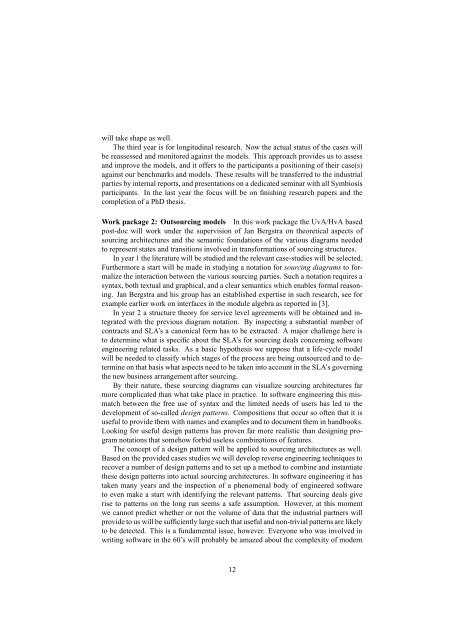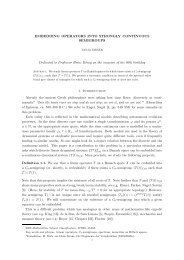Symbiosis - Universiteit van Amsterdam
Symbiosis - Universiteit van Amsterdam
Symbiosis - Universiteit van Amsterdam
Create successful ePaper yourself
Turn your PDF publications into a flip-book with our unique Google optimized e-Paper software.
will take shape as well.<br />
The third year is for longitudinal research. Now the actual status of the cases will<br />
be reassessed and monitored against the models. This approach provides us to assess<br />
and improve the models, and it offers to the participants a positioning of their case(s)<br />
against our benchmarks and models. These results will be transferred to the industrial<br />
parties by internal reports, and presentations on a dedicated seminar with all <strong>Symbiosis</strong><br />
participants. In the last year the focus will be on finishing research papers and the<br />
completion of a PhD thesis.<br />
Work package 2: Outsourcing models In this work package the UvA/HvA based<br />
post-doc will work under the supervision of Jan Bergstra on theoretical aspects of<br />
sourcing architectures and the semantic foundations of the various diagrams needed<br />
to represent states and transitions involved in transformations of sourcing structures.<br />
In year 1 the literature will be studied and the rele<strong>van</strong>t case-studies will be selected.<br />
Furthermore a start will be made in studying a notation for sourcing diagrams to formalize<br />
the interaction between the various sourcing parties. Such a notation requires a<br />
syntax, both textual and graphical, and a clear semantics which enables formal reasoning.<br />
Jan Bergstra and his group has an established expertise in such research, see for<br />
example earlier work on interfaces in the module algebra as reported in [3].<br />
In year 2 a structure theory for service level agreements will be obtained and integrated<br />
with the previous diagram notation. By inspecting a substantial number of<br />
contracts and SLA’s a canonical form has to be extracted. A major challenge here is<br />
to determine what is specific about the SLA’s for sourcing deals concerning software<br />
engineering related tasks. As a basic hypothesis we suppose that a life-cycle model<br />
will be needed to classify which stages of the process are being outsourced and to determine<br />
on that basis what aspects need to be taken into account in the SLA’s governing<br />
the new business arrangement after sourcing.<br />
By their nature, these sourcing diagrams can visualize sourcing architectures far<br />
more complicated than what take place in practice. In software engineering this mismatch<br />
between the free use of syntax and the limited needs of users has led to the<br />
development of so-called design patterns. Compositions that occur so often that it is<br />
useful to provide them with names and examples and to document them in handbooks.<br />
Looking for useful design patterns has proven far more realistic than designing program<br />
notations that somehow forbid useless combinations of features.<br />
The concept of a design pattern will be applied to sourcing architectures as well.<br />
Based on the provided cases studies we will develop reverse engineering techniques to<br />
recover a number of design patterns and to set up a method to combine and instantiate<br />
these design patterns into actual sourcing architectures. In software engineering it has<br />
taken many years and the inspection of a phenomenal body of engineered software<br />
to even make a start with identifying the rele<strong>van</strong>t patterns. That sourcing deals give<br />
rise to patterns on the long run seems a safe assumption. However, at this moment<br />
we cannot predict whether or not the volume of data that the industrial partners will<br />
provide to us will be sufficiently large such that useful and non-trivial patterns are likely<br />
to be detected. This is a fundamental issue, however. Everyone who was involved in<br />
writing software in the 60’s will probably be amazed about the complexity of modern<br />
12

















